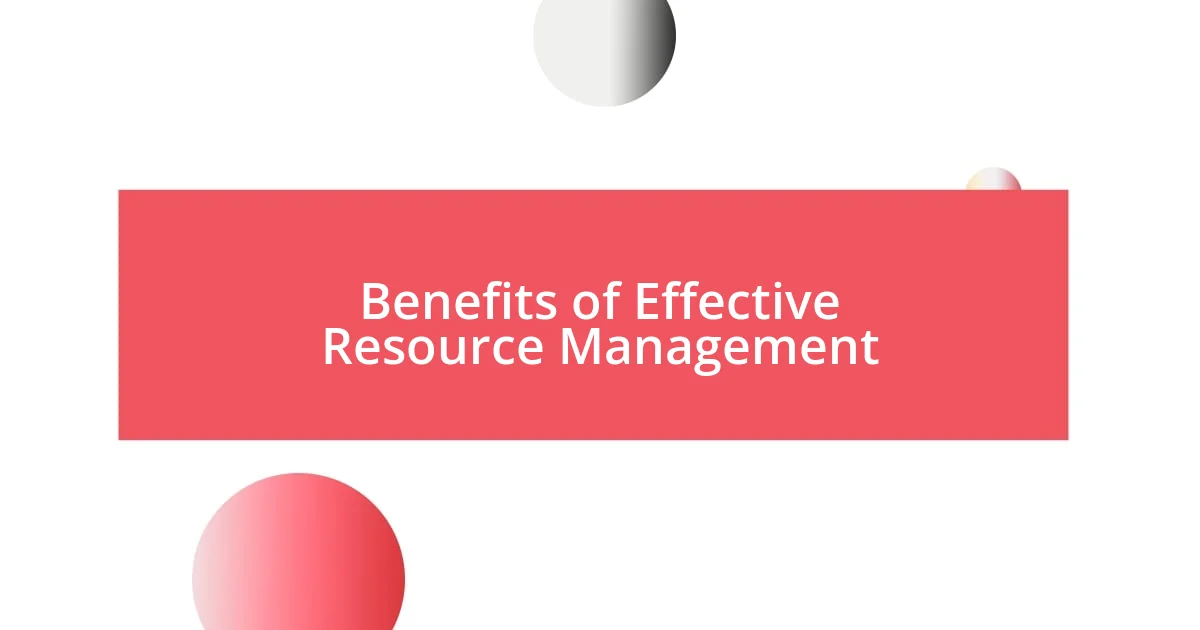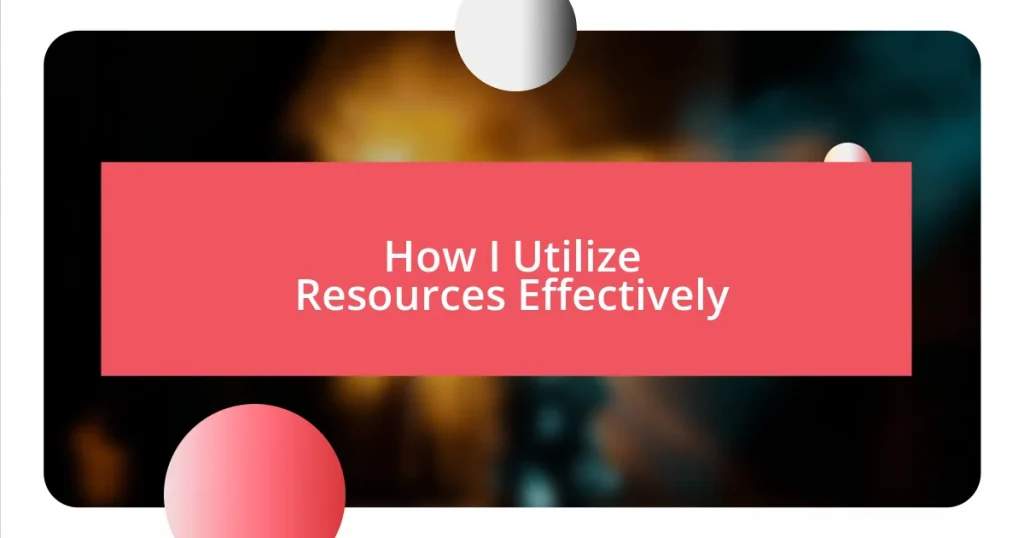Key takeaways:
- Effective resource utilization requires strategic alignment with goals, self-awareness, and adaptability, leading to enhanced productivity and innovation.
- Regular assessment and reallocation of resources, along with team collaboration, foster better decision-making and increased efficiency.
- Continuous improvement involves measuring effectiveness, learning from failures, and being open to experimentation, which can drive significant project successes.

Understanding Resource Utilization
Understanding how to utilize resources effectively is crucial in both personal and professional contexts. I remember a time when I was juggling multiple projects at work. I realized that not managing my resources properly left me feeling overwhelmed. This experience taught me that resource utilization isn’t just about using what you have available; it’s about being strategic—thinking ahead and aligning your resources with your goals.
When I started prioritizing resources, I implemented a simple habit: I would regularly assess what I had at my disposal. This process not only included tools and materials but also time and energy. It was eye-opening to realize how often I relied on outdated methods that drained my energy instead of enhancing my productivity.
I’ve learned that effective resource utilization requires self-awareness and adaptability. Have you ever noticed how flexible you can be when faced with constraints? I find that those challenges often lead to creative solutions I never would have considered otherwise. By embracing limitations, I’ve discovered that is often within those boundaries that the best ideas emerge.

Benefits of Effective Resource Management
Effective resource management can lead to remarkable benefits that enhance both efficiency and satisfaction. I once managed a team project where we faced tight deadlines and limited budget. By effectively utilizing our resources, we not only completed the project ahead of schedule, but team morale skyrocketed as everyone felt more empowered and engaged in their roles. That experience reinforced my belief that when resources are allocated wisely, the results can be transformative.
Here are some specific benefits I’ve observed from effective resource management:
– Increased Efficiency: With the right tools and time management, tasks get completed faster.
– Cost Savings: Proper allocation prevents unnecessary expenses, allowing for a healthier budget.
– Enhanced Team Morale: When individuals feel supported by clear resource management, they are more motivated and committed.
– Greater Innovation: Limited resources often spark creativity, leading to unexpected, innovative solutions.
– Better Decision-Making: When you understand your resources, making informed choices becomes much easier.

Identifying Available Resources
Identifying available resources starts with a thorough inventory of what you have. I often find myself feeling surprised at the array of tools, skills, and even connections around me. For instance, the last time I tackled a community project, I was amazed at how many volunteers offered unique skills that I hadn’t tapped into before. This process of evaluation helped me understand that sometimes our most valuable resources are hidden in plain sight.
Once I take stock of my immediate resources, the next step is assessing their potential. I remember a specific instance when I was considering a new marketing strategy for my side business. By utilizing social media connections and a few free online tools, I launched a campaign that exceeded my expectations. This made me realize that identifying available resources isn’t just listing assets but also exploring how they can intersect creatively.
Lastly, it’s essential to think about the intangible resources at your disposal. For example, my network of friends and colleagues often serves as a sounding board for ideas. I encourage you to reach out and tap into such networks. By embracing this broader view of resources, I found innovative solutions that set me apart from competitors in my field.
| Type of Resource | Examples |
|---|---|
| Tangible | Tools, Equipment, Office Space |
| Intangible | Knowledge, Skills, Connections |

Strategies for Resource Allocation
I’ve found that setting clear priorities is one of my most effective strategies for resource allocation. Once, when juggling multiple projects, I learned the hard way that not everything is equally important. By focusing on high-impact tasks first, I noticed a significant boost in productivity without overwhelming myself. How often do we get sidetracked by the inconsequential? This clarity not only helps in decision-making but also ensures that energy is channeled where it matters most.
Another strategy I’ve incorporated is the practice of regular check-ins with my team. In one project, we established weekly meetings to assess our resource utilization and make adjustments. This openness not only fostered collaboration but also revealed areas where we could improve efficiency. Have you ever found that some ideas become much clearer with a little group dialogue? These discussions can illuminate innovative uses for our existing resources that we might overlook when working in isolation.
I also believe in embracing flexibility with resource allocation. There was a time when I was reluctant to shift my focus from one project to another. However, I realized that adapting to changing circumstances often leads to unexpected benefits. When a sudden opportunity arose in another area, I quickly reallocated my resources, which resulted in not just capturing that chance but also reinvigorating my team’s enthusiasm. Perhaps it’s this adaptability that keeps us not only relevant but also passionate about our work.

Tools for Resource Tracking
When it comes to tracking resources effectively, I’ve often turned to project management tools like Trello and Asana. The visual boards or lists they provide help me see everything at a glance, making it easy to assign tasks and monitor progress. I remember a time when I used Trello for organizing a community workshop; it not only helped us keep track of supplies but also allowed volunteers to claim tasks, fostering a sense of ownership and accountability. Have you ever noticed how a small tweak in organization can make a massive difference in efficiency?
Another tool I’ve found invaluable is Google Sheets. I often create detailed spreadsheets to log resources, whether it’s tracking inventory for a project or mapping out my network. The best part? It’s collaborative, so I can share it with team members who can provide real-time updates. I still recall the relief I felt during a tight deadline when a teammate updated the sheet, showing we had what we needed, thus preventing last-minute panic. The simplicity of sharing information couldn’t be overstated; it makes everyone feel involved and informed.
Finally, I think about the use of time-tracking software like Toggl. I’m often juggling several responsibilities, and it’s all too easy to lose track of where my hours are going. By keeping tabs on how I spend my time, I’ve discovered those hidden pockets of productivity—and those discouraging stretches where I seemed busy yet accomplished little. Each insight I gained prompted questions about my workflow, and honestly, questioning habits is an essential part of improving. Have you checked how your time is being spent lately? You might find you have more room for important tasks than you thought!

Measuring Resource Effectiveness
Measuring the effectiveness of resources involves tracking tangible outcomes and the overall impact on my objectives. I remember a project where we set specific metrics such as cost savings and project completion time. By analyzing these figures post-project, I gained invaluable insights into what worked and what didn’t. How can we improve without reflecting on our past efforts?
Using feedback from team members has also proven essential in determining resource effectiveness. During a recent initiative, I conducted a survey asking for input on how resources were utilized. The responses surprised me; I was able to address inefficiencies I hadn’t noticed. Have you ever discovered that those closest to the action often hold the key to unlocking greater effectiveness?
Lastly, I like to revisit past performance data to ensure continuous improvement. For instance, after wrapping up a marketing campaign, I would dive deep into analytics to assess engagement and return on investment. This practice revealed patterns that shaped future strategies, leading to better resource use over time. Don’t you find it fascinating how data can tell stories we might miss otherwise?

Continuous Improvement in Resource Use
Continuous improvement in resource use is a journey I actively embrace. When I think back to a project where we implemented regular check-ins, I realize how those moments became opportunities for reflection and adjustment. During these meetings, I often found myself reinvigorated by my team’s ideas—small changes like reallocating resources or shifting deadlines led to noticeable improvements in efficiency. Have you set aside time to rethink your resource strategies lately?
In my experience, embracing a mindset of experimentation can drive remarkable results. I once initiated a trial run of a new communication platform during a crucial phase of a project. Surprisingly, instead of the expected confusion, it sparked creativity and blurred the silos in our teamwork. Seeing my team collaborate more fluidly was not only rewarding but also reinforced my belief that being open to new approaches can lead to incredible outcomes. How often do you allow yourself to step outside the norm?
I also emphasize learning from failure as a cornerstone of continuous improvement. A few years ago, I was part of a campaign that missed its target due to misallocated efforts. Instead of sweeping the shortcomings under the rug, we hosted a debriefing session, dissecting what went wrong and how our resource decisions influenced the outcome. That experience taught me the value of transparency and accountability—having those tough conversations helps transform setbacks into stepping stones for future projects. Have you ever turned a failure into a guiding light for your next steps?















